Unveiling the Potential of Novel Ternary Chalcogenide SrHfSe3 for Eco-Friendly, Self-Powered, Near-Infrared Photodetectors: A SCAPS-1D Simulation Study
Abstract
1. Introduction
2. Materials and Methods
Proposed Design and Band Alignment
3. Results and Discussions
3.1. The Impact of Absorber Layer SrHfSe3 on the Photodetector Performance
3.2. The Impact of Window Layer (ZnSe) on the Photodetector Performance
3.3. The Impact of the BSF Layer (AgCuS) on the Photodetector Performance
3.4. The Impact of the Interfacial Defects on the Photodetector Performance
3.5. The Impact of the Working Temperature on the Photodetector Performance
3.6. The Impact of the SrHfSe3 Bandgap Tuning on the Photodetector Performance
3.7. The Impact of the Change in the Input Power on the Phototodetector Performance
3.8. The Impact of the Series, Shunt Resistance, and Electron Affinity on the SrHfSe3 Photodetector Performance
3.9. The Built-In Potential of the Photodetector
3.10. The Optimized Design with and Without the BSF Layer
3.11. Performance Comparison
| Structure | Types of Work | λ(nm) | Software Used /Method | Responsivity (A/W) | Detectivity (Jones) | Reference |
|---|---|---|---|---|---|---|
| Si:S | Experimental | 1310 | Ion implantation + rapid thermal annealing | 0.1073 | - | [79] |
| p-WSe2/n-Ge | Experimental | 1550 | Mechanical exfoliation + Ion implantation | 1.3 | 2.5 × 1010 | [80] |
| InGaAs/InAs | Experimental | 1550 2000 | CVD | 0.6 at 1550 nm 15 at 2000 nm | 2.4 × 1014 3.8 × 1010 | [11] |
| p-n Ge | Simulation | 1550 | Lumerical Change FDTD | 0.43 | - | [47] |
| Graphene/GaAs | Simulation | 725 | COMSOL Multiphysics | 0.514 | 1.16 × 1011 | [81] |
| InGaAs/InAs/InSb/InP HEMT | Simulation | 900–1700 | TCAD Silvaco | 15.75 | 4.0384 × 1010 | [49] |
| p-MoS2 | Simulation | 700 | SCAPS-1D | 0.37 | 3.27 × 1014 | [82] |
| n-CdS/p-Cu2ZnGeSe4/p+-ZnTe | Simulation | 780 | SCAPS-1D | 0.58 | 8.28 × 1017 | [46] |
| PbS/TiS3 | Simulation | 780 | SCAPD 1D | 0.36 | 3.9 × 1013 | [4] |
| n-ZnSe/p-TiSe2/p+-WSe2 | Simulation | 920 | SCAPS 1D | 0.670 | 12.90 × 1014 | [41] |
| n-In2S3/p-BeSiP2/p+-MoS2 | Simulation | 860 | SCAPS 1D | 0.64 | 3.63 × 1016 | [67] |
| n-WS2/p-Ag3CuS2/p+-BaSi2 | Simulation | 1065 | SCPDS 1D | 0.790 | 4.73 × 1014 | [63] |
| n-ZnSe/p-SrHfSe3/p+-AgCuS | Simulation | 1100 | SCAPS-1D | 0.850 | 2.26 × 1014 | This work |
4. Conclusions
Author Contributions
Funding
Institutional Review Board Statement
Data Availability Statement
Acknowledgments
Conflicts of Interest
Abbreviations
| AgCuS | silver copper disulfide |
| CBM | conduction band minimum |
| EC/EV | energy level of the conduction/valence band |
| ETL/HTL | electron/hole transport layer |
| Eg | bandgap |
| HgCdTe | mercury cadmium telluride |
| InGaAs | indium gallium arsenide |
| JSC | short-circuit current density |
| J–V | current voltage |
| NIR | near infrared |
| Nt | defect density |
| PDs | photodetectors (PDs) |
| QE | quantum efficiency |
| Rs | series resistance |
| Rsh | shunt resistance |
| SCAPS-1D | solar cell capacitance simulator one-dimension |
| SrHfSe3 | strontium hafnium selenide |
| VBM | valence band maximum |
| VOC | open-circuit voltage |
| Vbi | built-in potential |
| ZnSe | zinc sulfide |
References
- Lee, J.-J.; Han, S.-J.; Hwang, D.K. Understanding Photoinduced Memory Effects in Optoelectronic Devices across Photoresponse Time Scales for Sensor-Based Artificial Intelligence. ACS Photonics 2025, 12, 2262–2278. [Google Scholar] [CrossRef]
- Kumar, A.; Chakkar, A.G.; Das, C.; Kumar, P.; Sahu, S.; Saliba, M.; Kumar, M. Self-Powered Broadband Photodetectors Based on WS2-Anchored MoS2 with Enhanced Responsivity and Detectivity. Small 2025, 21, 2502900. [Google Scholar] [CrossRef]
- Roy, N. Investigating Cs2SnI6 as a promising material for high-performance self-powered broadband photodetection application. J. Phys. Chem. Solids 2025, 203, 112730. [Google Scholar] [CrossRef]
- Yao, H.; Liu, L. Design and optimize the performance of self-powered photodetector based on PbS/TiS3 heterostructure by SCAPS-1D. Nanomaterials 2022, 12, 325. [Google Scholar] [CrossRef] [PubMed]
- Mahato, S.; Tamulewicz-Szwajkowska, M.; Singh, S.; Kowal, D.; Bose, S.; Serafińczuk, J.; Czyż, K.; Jędrzejewski, R.; Birowosuto, M.D.; Ray, S.K.; et al. Surface-Engineered Methylammonium Lead Bromide Single Crystals: A Platform for Fluorescent Security Tags and Photodetector Applications. Adv. Opt. Mater. 2024, 12, 2302257. [Google Scholar] [CrossRef]
- Abdo, S.; As’ ham, K.; Odebowale, A.A.; Akter, S.; Abdulghani, A.; Al Ani, I.A.; Hattori, H.; Miroshnichenko, A.E. A Near-Ultraviolet Photodetector Based on the TaC: Cu/4 H Silicon Carbide Heterostructure. Appl. Sci. 2025, 15, 970. [Google Scholar] [CrossRef]
- Srivastava, R.; Verma, S.; Chaudhary, A.K.; Sahu, A. Enhanced red light detection in eco-friendly perovskite-based photodetector with improved low-light sensitivity. Solid State Commun. 2025, 403, 115983. [Google Scholar] [CrossRef]
- Yasin, S.; Christopoulos, S.; Abu Waar, Z.; Moustafa, M. Numerical Modeling and Optimization of High-Performance CsSnI3 Perovskite Photodetectors. J. Electron. Mater. 2025, 54, 5690–5700. [Google Scholar] [CrossRef]
- Chen, B.; Xu, J.; Shi, S.; Kong, L.; Zhang, X.; Li, L. UV–Vis–NIR Broadband Self-Powered CuInS2/SnO2 Photodetectors and the Application in Encrypted Optical Communication. ACS Appl. Mater. Interfaces 2024, 16, 28917–28927. [Google Scholar] [CrossRef] [PubMed]
- Chen, J.; Zhang, Z.; Ma, Y.; Feng, J.; Xie, X.; Wang, X.; Jian, A.; Li, Y.; Li, Z.; Guo, H.; et al. High-performance self-powered ultraviolet to near-infrared photodetector based on WS2/InSe van der Waals heterostructure. Nano Res. 2023, 16, 7851–7857. [Google Scholar] [CrossRef]
- Woo, S.; Yeon, E.; Ryu, H.Y.; Han, J.H.; Jang, H.W.; Jung, D.; Choi, W.J. High Detectivity Dual-Band Infrared Photodetectors with Dislocation-Assisted Photoconductive Gain via Hetero-Epitaxial Growth. Adv. Funct. Mater. 2025, 35, 2419329. [Google Scholar] [CrossRef]
- Wang, Y.; Gu, Y.; Cui, A.; Li, Q.; He, T.; Zhang, K.; Wang, Z.; Li, Z.; Zhang, Z.; Wu, P.; et al. Fast uncooled mid-wavelength infrared photodetectors with heterostructures of van der Waals on epitaxial HgCdTe. Adv. Mater. 2022, 34, 2107772. [Google Scholar] [CrossRef] [PubMed]
- Li, Q.; Guo, Y.; Liu, Y. Exploration of near-infrared organic photodetectors. Chem. Mater. 2019, 31, 6359–6379. [Google Scholar] [CrossRef]
- Guo, Z.; Wang, J.; Du, J.; Wu, D.; Zeng, L.; Tsang, Y.H.; Wu, D.; Wang, Y.; Ding, Y.; Lin, P. Self-driven Te0.65Se0.35/GaAs SWIR photodiode with spectral response to 1.55 μm for broadband imaging and optical communication. Nano Energy 2025, 133, 110452. [Google Scholar] [CrossRef]
- Liu, C.; Guo, J.; Yu, L.; Li, J.; Zhang, M.; Li, H.; Shi, Y.; Dai, D. Silicon/2D-material photodetectors: From near-infrared to mid-infrared. Light Sci. Appl. 2021, 10, 123. [Google Scholar] [CrossRef]
- Liu, X. Highly strained Ge nanostructures and direct bandgap transition induced by femtosecond laser. Semicond. Sci. Technol. 2025, 40, 045013. [Google Scholar] [CrossRef]
- Zhang, X.; Shao, J.; Du, S.; Lu, T.; Wang, Y.; Wang, F.; Geng, Y.; Tang, Z. Ultra-broadband, self-powered and high performance vertical WSe2/AlOx/Ge heterojunction photodetector with MXene electrode. J. Alloys Compd. 2023, 930, 167484. [Google Scholar] [CrossRef]
- Son, B.; Lin, Y.; Lee, K.H.; Chen, Q.; Tan, C.S. Dark current analysis of germanium-on-insulator vertical pin photodetectors with varying threading dislocation density. J. Appl. Phys. 2020, 127, 203105. [Google Scholar] [CrossRef]
- Wang, J.; Chen, J. High-sensitivity silicon: PbS quantum dot heterojunction near-infrared photodetector. Surf. Interfaces 2022, 30, 101945. [Google Scholar] [CrossRef]
- Peng, L.; Wang, Y.; Ren, Y.; Wang, Z.; Cao, P.; Konstantatos, G. InSb/InP Core–Shell Colloidal Quantum Dots for Sensitive and Fast Short-Wave Infrared Photodetectors. ACS Nano 2024, 18, 5113–5121. [Google Scholar] [CrossRef] [PubMed]
- Shiddique, S.N.; Mondal, B.K.; Hossain, J. Modeling of Ag3AuS2-based NIR photodetector with BaSi2 BSF layer for superior detectivity. Opt. Contin. 2025, 4, 649–667. [Google Scholar] [CrossRef]
- Guo, C.; Zhang, J.; Xu, W.; Liu, K.; Yuan, X.; Qin, S.; Zhu, Z. Graphene-based perfect absorption structures in the visible to terahertz band and their optoelectronics applications. Nanomaterials 2018, 8, 1033. [Google Scholar] [CrossRef]
- Wu, J.; Lu, Y.; Feng, S.; Wu, Z.; Lin, S.; Hao, Z.; Yao, T.; Li, X.; Zhu, H.; Lin, S. The interaction between quantum dots and graphene: The applications in graphene-based solar cells and photodetectors. Adv. Funct. Mater. 2018, 28, 1804712. [Google Scholar] [CrossRef]
- Sultana, N.; Degg, A.; Upadhyaya, S.; Nilges, T.; Sarma, N.S. Synthesis, modification, and application of black phosphorus, few-layer black phosphorus (FLBP), and phosphorene: A detailed review. Mater. Adv. 2022, 3, 5557–5574. [Google Scholar] [CrossRef]
- Abate, Y.; Akinwande, D.; Gamage, S.; Wang, H.; Snure, M.; Poudel, N.; Cronin, S.B. Recent progress on stability and passivation of black phosphorus. Adv. Mater. 2018, 30, 1704749. [Google Scholar] [CrossRef]
- Odebowale, A.A.; Berhe, A.M.; Somaweera, D.; Wang, H.; Lei, W.; Miroshnichenko, A.E.; Hattori, H.T. Advances in 2D Photodetectors: Materials, Mechanisms, and Applications. Micromachines 2025, 16, 776. [Google Scholar] [CrossRef]
- Wang, Z.; Tan, C.; Peng, M.; Yu, Y.; Zhong, F.; Wang, P.; He, T.; Wang, Y.; Zhang, Z.; Xie, R. Giant infrared bulk photovoltaic effect in tellurene for broad-spectrum neuromodulation. Light Sci. Appl. 2024, 13, 277. [Google Scholar] [CrossRef]
- Amani, M.; Tan, C.; Zhang, G.; Zhao, C.; Bullock, J.; Song, X.; Kim, H.; Shrestha, V.R.; Gao, Y.; Crozier, K.B.; et al. Solution-synthesized high-mobility tellurium nanoflakes for short-wave infrared photodetectors. ACS Nano 2018, 12, 7253–7263. [Google Scholar] [CrossRef] [PubMed]
- Yan, Z.; Yang, H.; Yang, Z.; Ji, C.; Zhang, G.; Tu, Y.; Du, G.; Cai, S.; Lin, S. Emerging two-dimensional tellurene and tellurides for broadband photodetectors. Small 2022, 18, 2200016. [Google Scholar] [CrossRef] [PubMed]
- Wu, X.; Gao, S.; Liu, W.; Huang, K. Self-assembled Te nanowire thin film/silicon heterostructure for cost-effective and fast photoresponse in near-infrared photodetector. Mater. Sci. Semicond. Process. 2024, 176, 108293. [Google Scholar] [CrossRef]
- Shiddique, S.N.; Abir, A.T.; Nushin, S.S.; Mondal, B.K.; Hossain, J. Numerical probing into the role of experimentally developed ZnTe window layer in high-performance Ag3AuSe2 photodetector. Results Mater. 2025, 25, 100651. [Google Scholar] [CrossRef]
- Gupta, T.; Ghoshal, D.; Yoshimura, A.; Basu, S.; Chow, P.K.; Lakhnot, A.S.; Pandey, J.; Warrender, J.M.; Efstathiadis, H.; Soni, A.; et al. An environmentally stable and lead-free chalcogenide perovskite. Adv. Funct. Mater. 2020, 30, 2001387. [Google Scholar] [CrossRef]
- Wang, Y.; Liu, Y.; Cao, S.; Wang, J. A review on solution-processed perovskite/organic hybrid photodetectors. J. Mater. Chem. C 2021, 9, 5302–5322. [Google Scholar] [CrossRef]
- Adhikari, S.; Johari, P. Photovoltaic properties of ABSe3 chalcogenide perovskites (A = Ca, Sr, Ba; B = Zr, Hf). Phys. Rev. B 2024, 109, 174114. [Google Scholar] [CrossRef]
- Aly, K.; Thakur, N.; Kumar, P.; Saddeek, Y.; Shater, T.; Ismail, Y.A.; Sharma, P. Optimizing solar cell performance with chalcogenide perovskites: A numerical study of BaZrSe3 absorber layers. Sol. Energy 2024, 282, 112961. [Google Scholar] [CrossRef]
- Buffiere, M.; Dhawale, D.S.; El-Mellouhi, F. Chalcogenide materials and derivatives for photovoltaic applications. Energy Technol. 2019, 7, 1900819. [Google Scholar] [CrossRef]
- Liang, Y.; Zhang, Y.; Xu, J.; Ma, J.; Jiang, H.; Li, X.; Zhang, B.; Chen, X.; Tian, Y.; Han, Y. Parametric study on controllable growth of SrZrS3 thin films with good conductivity for photodetectors. Nano Res. 2023, 16, 7867–7873. [Google Scholar] [CrossRef]
- Lu, Y.; Yu, W.; Zhang, Y.; Zhang, J.; Chen, C.; Dai, Y.; Hou, X.; Dong, Z.; Yang, L.; Fang, L.; et al. Synthesis and Broadband Photodetection of a P-Type 1D Van der Waals Semiconductor HfSnS3. Small 2023, 19, 2303903. [Google Scholar] [CrossRef] [PubMed]
- Moroz, N.A.; Bauer, C.; Williams, L.; Olvera, A.; Casamento, J.; Page, A.A.; Bailey, T.P.; Weiland, A.; Stoyko, S.S.; Kioupakis, E.; et al. Insights on the synthesis, crystal and electronic structures, and optical and thermoelectric properties of Sr1−xSbxHfSe3 orthorhombic perovskite. Inorg. Chem. 2018, 57, 7402–7411. [Google Scholar] [CrossRef]
- Singh, N.; Samanta, K.; Maharana, S.K.; Pal, K.; Tretiak, S.; Talapatra, A.; Ghosh, D. High-throughput and data-driven search for stable optoelectronic AMSe3 materials. J. Mater. Chem. A 2025, 13, 9192–9210. [Google Scholar] [CrossRef]
- Miah, M.R.; Ebon, M.I.R.; Abir, A.T.; Hossain, J. Modeling and Numerical Insights of TiSe2 Compound-Based Photodetector. Adv. Theory Simul. 2024, 7, 2400389. [Google Scholar] [CrossRef]
- Ebon, M.I.R.; Abir, A.T.; Pathak, D.; Hossain, J. Theoretical insights toward a highly responsive AgInSe2 photodetector. Appl. Res. 2024, 3, e202400038. [Google Scholar] [CrossRef]
- Srivastava, V.; Chauhan, R.; Pandey, A.; Mishra, V.L.; Mitharwal, C.; Bajpai, R.; Srivastava, M.; Verma, G.; Kumar, R.; Singh, S. Enhanced sensitivity of photodetectors with ZnSe as electron transport layer and Cz-Pyr as hole transport layer. J. Phys. Chem. Solids 2025, 203, 112712. [Google Scholar] [CrossRef]
- Li, N.H.; Zhang, Q.; Shi, X.L.; Jiang, J.; Chen, Z.G. Silver copper chalcogenide thermoelectrics: Advance, controversy, and perspective. Adv. Mater. 2024, 36, 2313146. [Google Scholar] [CrossRef]
- Tokuhara, Y.; Tezuka, K.; Shan, Y.J.; Imoto, H. Syntheses of complex sulfides AgCuS and Ag3CuS2 from the elements under hydrothermal conditions. J. Ceram. Soc. Jpn. 2009, 117, 359–362. [Google Scholar] [CrossRef][Green Version]
- Islam, M.C.; Pappu, M.A.H.; Ahmed, T.; Hossain, J. Theoretical Sagacity of an Efficient Cu2ZnGeSe4-Based Thin Film Solar Cell and Photodetector. Adv. Theory Simul. 2025, e01272. [Google Scholar] [CrossRef]
- Masoudian Saadabad, R.; Pauly, C.; Herschbach, N.; Neshev, D.N.; Hattori, H.T.; Miroshnichenko, A.E. Highly efficient near-infrared detector based on optically resonant dielectric nanodisks. Nanomaterials 2021, 11, 428. [Google Scholar] [CrossRef]
- Mal, I.; Singh, S.; Samajdar, D.P. Design and simulation of InAsBi PIN photodetector for Long wavelength Infrared applications. Mater. Today Proc. 2022, 57, 289–294. [Google Scholar] [CrossRef]
- Azzouz-Rached, A.; Batoo, K.M.; Ijaz, M.F.; Bencherif, H.; Bendjemai, M.; Sasikumar, P. Enhancing InGaAs/InAs/InSb/InP HEMT photodetector performance with black phosphorus-doped boron: Insights from DFT and Atlas Silvaco simulations. Sens. Actuators A Phys. 2025, 383, 116197. [Google Scholar]
- Hossain, M.K.; Islam, S.; Sakib, M.N.; Uddin, M.S.; Toki, G.F.; Rubel, M.H.; Nasrin, J.; Shahatha, S.H.; Mohammad, M.; Alothman, A.A.; et al. Exploring the optoelectronic and photovoltaic characteristics of lead-free Cs2TiBr6 double perovskite solar cells: A DFT and SCAPS-1D investigations. Adv. Electron. Mater. 2025, 11, 2400348. [Google Scholar] [CrossRef]
- Dubey, V.; Srivastava, A.; Sinha, R.; Roy, N. Design and optimization of high-performance MoSe2/PC60BM heterostructure based self-powered photodetector. Mater. Sci. Eng. B 2025, 314, 118018. [Google Scholar] [CrossRef]
- Sabbah, H.; Abdel Baki, Z.; Mezher, R.; Arayro, J. SCAPS-1D modeling of hydrogenated lead-free Cs2AgBiBr6 double perovskite solar cells with a remarkable efficiency of 26.3%. Nanomaterials 2023, 14, 48. [Google Scholar] [CrossRef]
- Khan, T.M.; Ahmed, S.R.A. Investigating the Performance of FASnI3-Based Perovskite Solar Cells with Various Electron and Hole Transport Layers: Machine Learning Approach and SCAPS-1D Analysis. Adv. Theory Simul. 2024, 7, 2400353. [Google Scholar] [CrossRef]
- Chetia, A.; Saikia, D.; Sahu, S. Design and optimization of the performance of CsPbI3 based vertical photodetector using SCAPS simulation. Optik 2022, 269, 169804. [Google Scholar] [CrossRef]
- Islam, M.C.; Mondal, B.K.; Pappu, M.A.H.; Hossain, J. Numerical evaluation and optimization of high sensitivity Cu2CdSnSe4 photodetector. Heliyon 2024, 10, e36821. [Google Scholar] [CrossRef]
- Rahmoune, A.; Babahani, O. Performance analysis of tungsten disulfide (WS2) as HTL for MoS2 solar cell with ZnSe ETL and graphene as window layer. J. Opt. 2024, 1–21. [Google Scholar] [CrossRef]
- Srinivasan, D.; Rasu Chettiar, A.-D.; Vincent Mercy, E.N.; Marasamy, L. Scrutinizing the untapped potential of emerging ABSe3 (A = Ca, Ba; B = Zr, Hf) chalcogenide perovskites solar cells. Sci. Rep. 2025, 15, 3454. [Google Scholar] [CrossRef] [PubMed]
- Srinivasan, D.; Chettiar, A.-D.R.; Marasamy, L. Engineering BaHfS3 with Zr alloying to improve solar cell performance: Insights from SCAPS-1D simulations. Mater. Sci. Eng. B 2025, 315, 118126. [Google Scholar] [CrossRef]
- Chawki, N.; Rouchdi, M.; Alla, M.; Fares, B. Simulation and analysis of high-performance hole transport material SrZrS3-based perovskite solar cells with a theoretical efficiency approaching 26%. Sol. Energy 2023, 262, 111913. [Google Scholar] [CrossRef]
- Miah, M.H.; Rahman, M.B.; Islam, M.A.; Khandaker, M.U. Revealing the high-performance of a novel Ge-Sn-Based perovskite solar cell by employing SCAPS-1D. Phys. Scr. 2024, 99, 065969. [Google Scholar]
- Reza, M.S.; Ghosh, A.; Reza, M.S.; Aktarujjaman, M.; Talukder, M.J.; Aljazzar, S.O.; Al-Humaidi, J.Y.; Mukhrish, Y.E. Enhancing the Performance of Cs2TiBr6 Lead-Free Perovskite Solar Cells: A Simulation Study on the Impact of Electron and Hole Transport Layers. Langmuir 2025, 41, 6987–7007. [Google Scholar] [CrossRef]
- Pappu, M.A.H.; Mondal, B.K.; Shiddique, S.N.; Hossain, J. Comprehensive study on the optoelectronic properties of ZnSnP2 compound by DFT and simulation for the application in a photodetector. Phys. Scr. 2024, 99, 115991. [Google Scholar] [CrossRef]
- Shiddique, S.N.; Ebon, M.I.R.; Pappu, M.A.H.; Islam, M.C.; Hossain, J. Design and simulation of a high performance Ag3CuS2 jalpaite-based photodetector. Heliyon 2024, 10, e32247. [Google Scholar] [CrossRef]
- Miah, M.R.; Ebon, M.I.R.; Abir, A.T.; Hossain, J. A theoretical analysis to reveal the prospects of MoS2 as a back surface field layer in TiS3-based near infrared photodetector. Eng. Res. Express 2024, 6, 025338. [Google Scholar] [CrossRef]
- Asapu, S.; Moon, T.; Mahalingam, K.; Eyink, K.G.; Pagaduan, J.N.; Zhao, R.; Ganguli, S.; Katsumata, R.; Xia, Q.; Williams, R.S.; et al. Accurate compact nonlinear dynamical model for a volatile ferroelectric ZrO2 capacitor. npj Unconv. Comput. 2024, 1, 7. [Google Scholar] [CrossRef]
- Weber, J.W.; Kunz, O.; Knaack, C.; Chung, D.; Barson, A.; Slade, A.; Ouyang, Z.; Gottlieb, H.; Trupke, T. Daylight photoluminescence imaging of photovoltaic systems using inverter-based switching. Prog. Photovolt. Res. Appl. 2024, 32, 643–651. [Google Scholar] [CrossRef]
- Pappu, M.A.H.; Ebon, M.I.R.; Hossain, J. Design and simulation of BeSiP2-based high-performance solar cell and photosensor. Sol. Energy 2024, 279, 112837. [Google Scholar] [CrossRef]
- Miah, M.R.; Ebon, M.I.R.; Abir, A.T.; Hossain, J. Discovering the inherent properties of CdS/TiTe2/Cu2Te near infrared photodetector: A computational analysis. Next Res. 2025, 2, 100262. [Google Scholar] [CrossRef]
- Kuddus, A.; Ismail, A.B.M.; Hossain, J. Design of a highly efficient CdTe-based dual-heterojunction solar cell with 44% predicted efficiency. Sol. Energy 2021, 221, 488–501. [Google Scholar] [CrossRef]
- Ebon, M.I.R.; Pappu, M.A.H.; Hossain, J. Theoretical insights onto CuTlS2 semiconductor towards efficient solar cell and photosensor. Next Mater. 2025, 6, 100297. [Google Scholar] [CrossRef]
- Ebon, M.I.R.; Pappu, M.A.H.; Shiddique, S.N.; Hossain, J. Unveiling the potentiality of a self-powered CGT chalcopyrite-based photodetector: Theoretical insights. Opt. Mater. Express 2024, 14, 907–921. [Google Scholar] [CrossRef]
- Lekshmy, R.R.; Raza, E.; Ahmad, Z.; Bhadra, J. Simulation and optimization of lead-free CH3NH3SnI3 perovskite solar cells using SCAPS-1D. Results Opt. 2025, 21, 100823. [Google Scholar] [CrossRef]
- Ali, W.; Quraishi, A.; Kumawat, K.; Khan, M.E.; Ali, S.K.; Khan, A.U.; Bashiri, A.H.; Ezzeldien, M.; Kattayat, S.; Alvi, P. Temperature and pressure dependent tunable GaAsSb/InGaAs QW heterostructure for application in IR-photodetector. Phys. Low-Dimens. Syst. Nanostruct. 2024, 160, 115939. [Google Scholar] [CrossRef]
- Kukreti, S.; Sapkota, D.J.; Ramawat, S.; Dixit, A. Near-infrared photodetector performance of Cu2ZnSnS4 in the metal-semiconductor-metal configuration: Theoretical studies. Optik 2022, 264, 169385. [Google Scholar] [CrossRef]
- Huang, Z.; Zhou, Y.; Luo, Z.; Yang, Y.; Yang, M.; Gao, W.; Yao, J.; Zhao, Y.; Yang, Y.; Zheng, Z. Integration of photovoltaic and photogating effects in a WSe2/WS2/p-Si dual junction photodetector featuring high-sensitivity and fast-response. Nanoscale Adv. 2023, 5, 675–684. [Google Scholar] [CrossRef]
- Kuddus, A.; Mostaque, S.K.; Hossain, J. Simulating the performance of a high-efficiency SnS-based dual-heterojunction thin film solar cell. Opt. Mater. Express 2021, 11, 3812–3826. [Google Scholar] [CrossRef]
- Adhikari, S.; Das, S.; Johari, P. Post-transition metal Sn-based chalcogenide perovskites: A promising lead-free and transition metal alternative for stable, high-performance photovoltaics. J. Mater. Chem. C 2025, 13, 7792–7805. [Google Scholar] [CrossRef]
- Srinivasan, D.; Chettiar, A.-D.R.; Arockiadoss, K.T.; Marasamy, L. A new class of SrHfSe3 chalcogenide perovskite solar cells with diverse HTMs: Theoretical modelling towards efficiency enhancement. Sol. Energy Mater. Sol. Cells 2025, 290, 113727. [Google Scholar] [CrossRef]
- Xiao, Y.; Deng, K.; Zhang, K.; Xu, X.; Li, Q.; Zhang, T.; Guo, J.; Lu, H.; Wang, P.; Hu, W. On-Chip Room-Temperature Operated Short-Wavelength-Infrared Si: S Photodetector with a Vertical Junction. Adv. Funct. Mater. 2024, 34, 2409354. [Google Scholar] [CrossRef]
- Lee, C.H.; Park, Y.; Youn, S.; Yeom, M.J.; Kum, H.S.; Chang, J.; Heo, J.; Yoo, G. Design of p-WSe2/n-Ge Heterojunctions for high-speed broadband photodetectors. Adv. Funct. Mater. 2022, 32, 2107992. [Google Scholar] [CrossRef]
- Wang, Y.; Fu, Y.; Zhao, J.; Liu, H.; Deng, L. Enhanced photoelectric responsivity of graphene/GaAs photodetector using surface plasmon resonance based on ellipse wall grating-nanowire structure. Plasmonics 2024, 19, 1201–1209. [Google Scholar] [CrossRef]
- Roy, N. Design and performance evaluation of MoS2 photodetector in vertical MSM configuration. Opt. Mater. 2024, 148, 114817. [Google Scholar] [CrossRef]
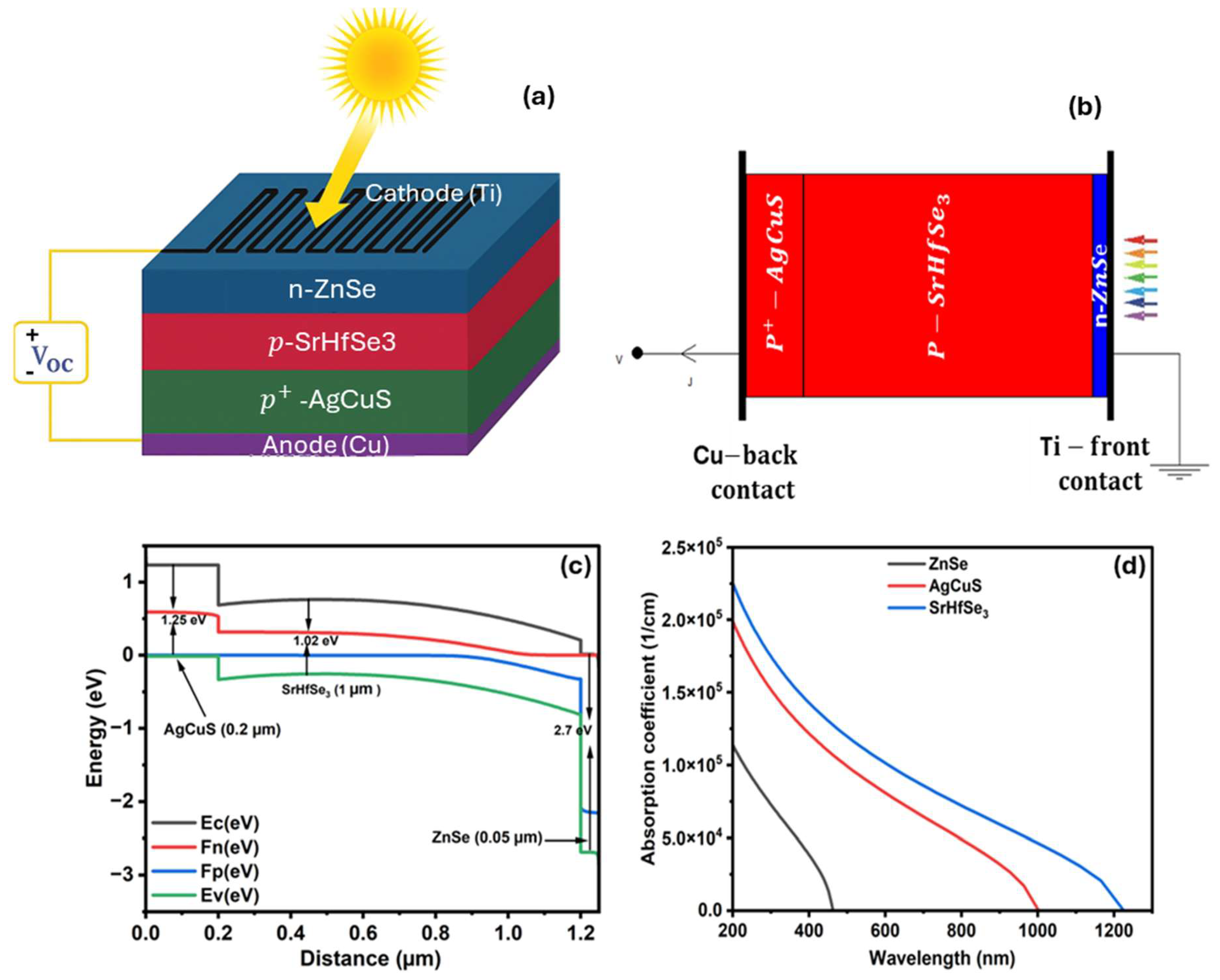
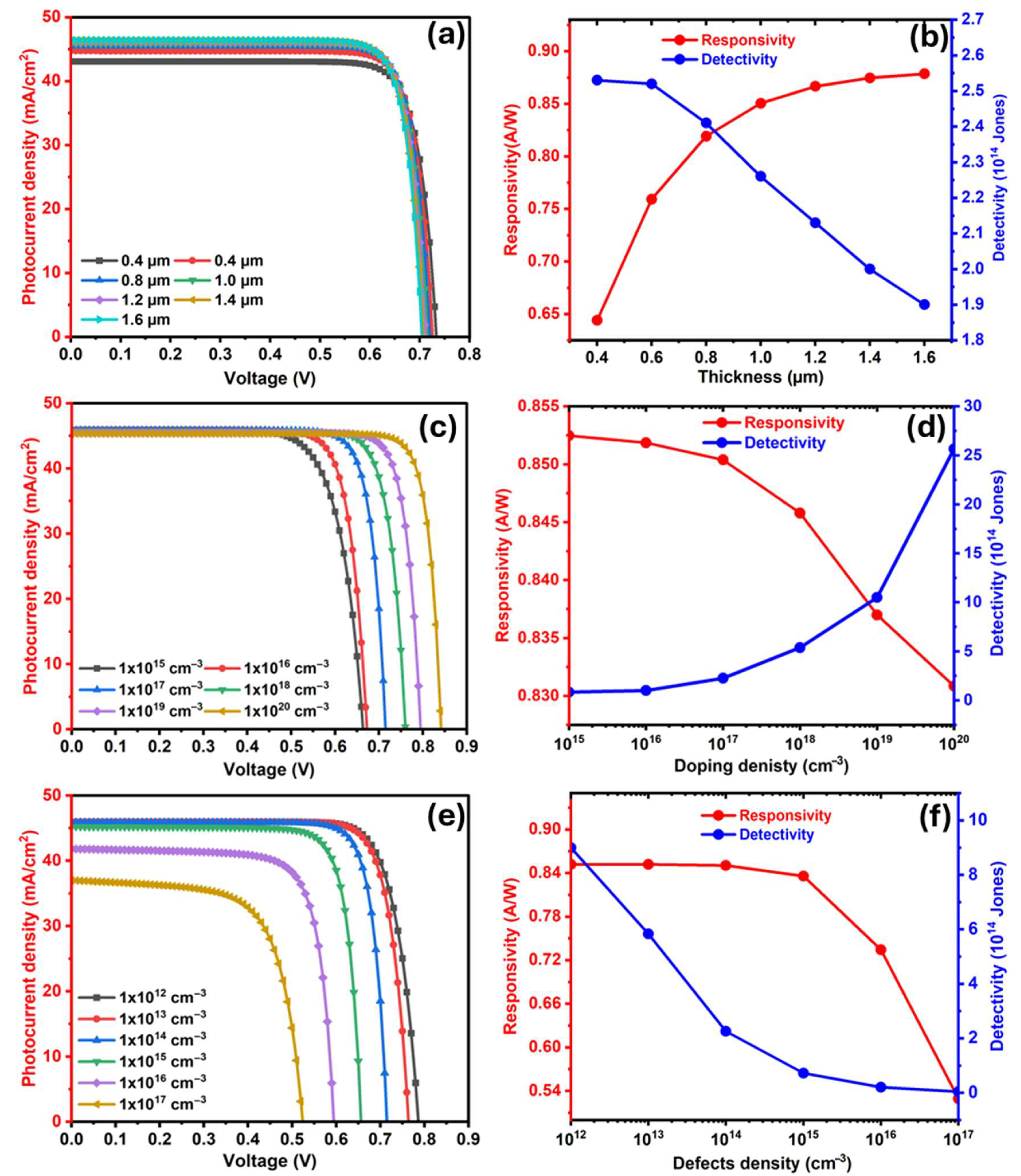
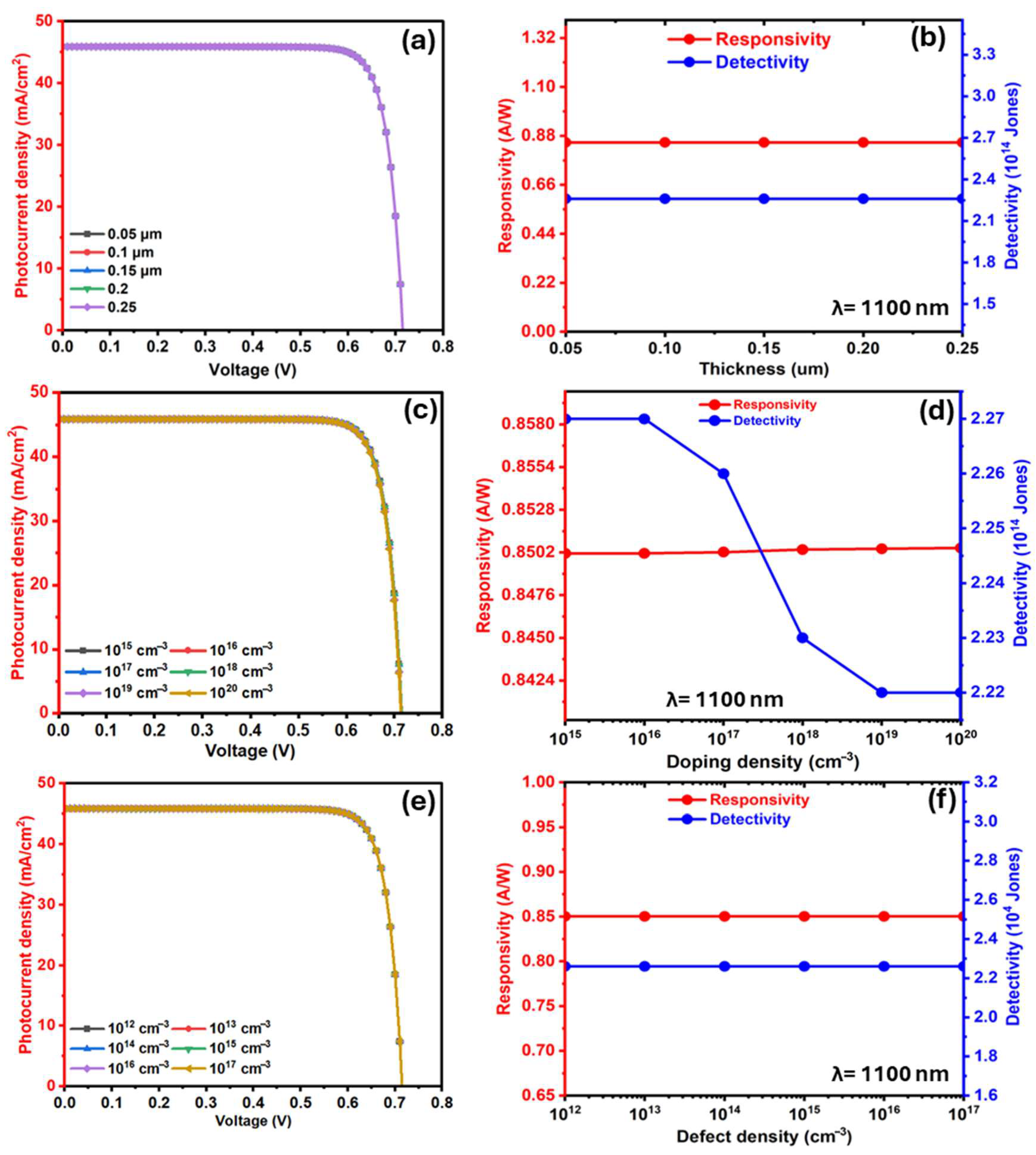
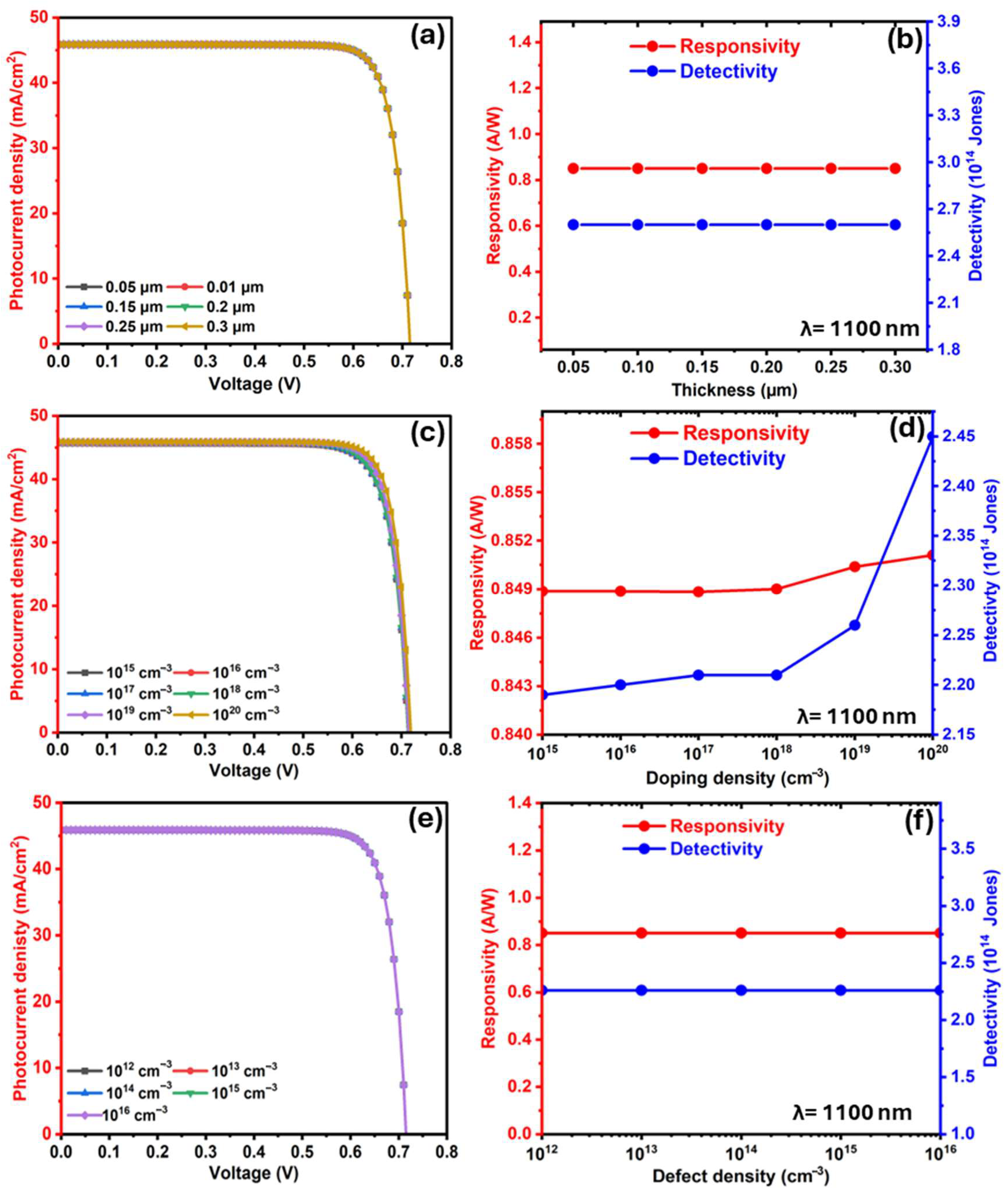
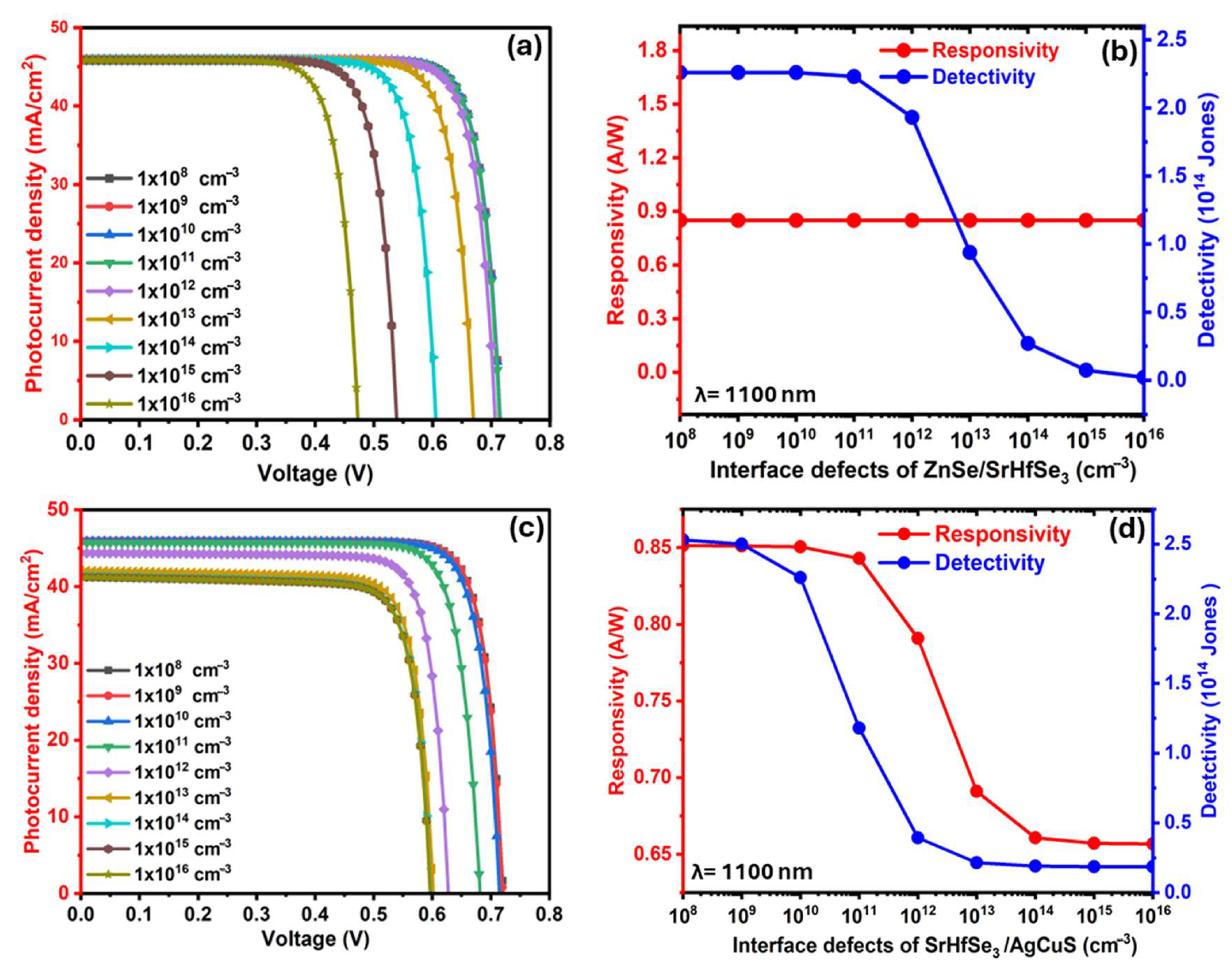

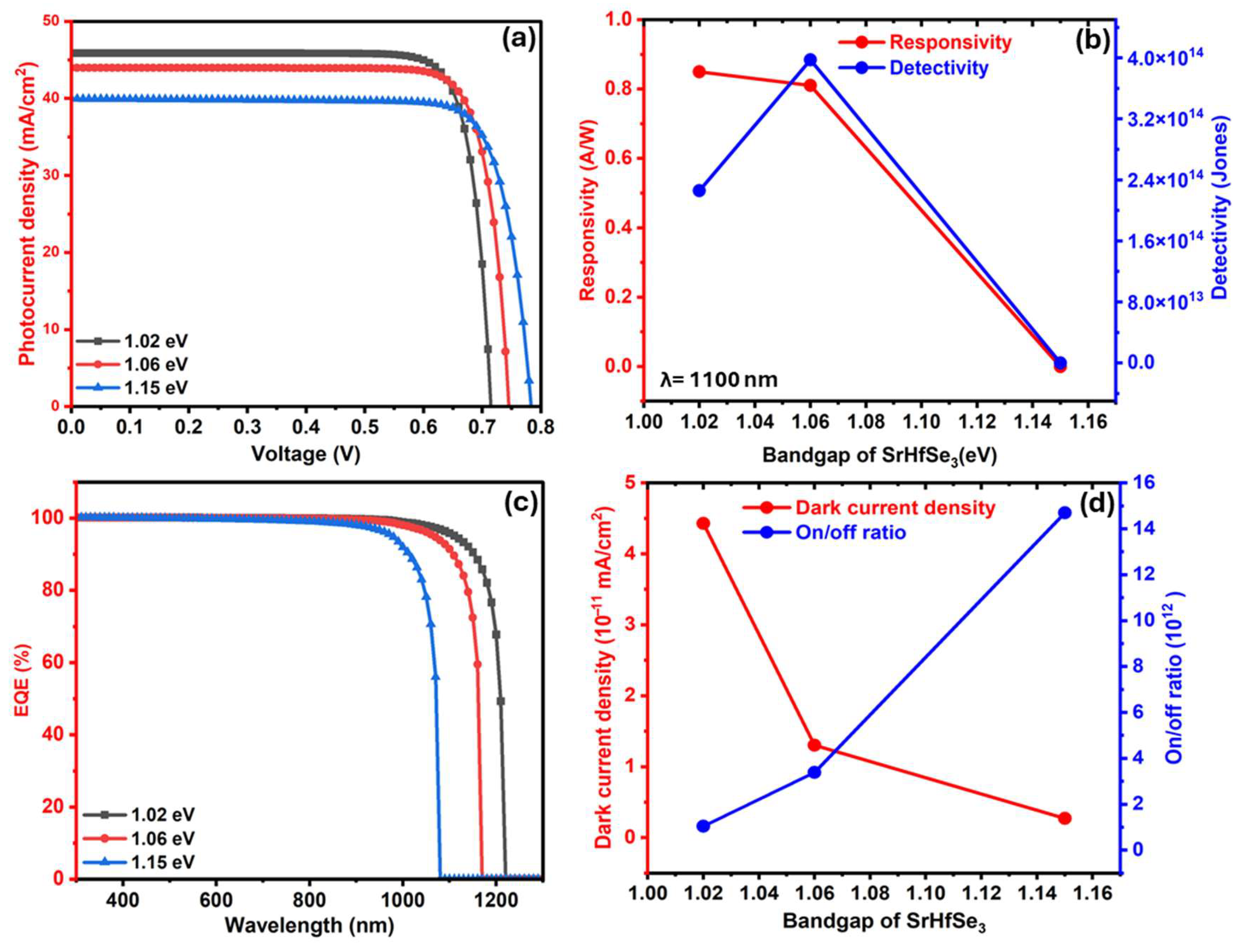


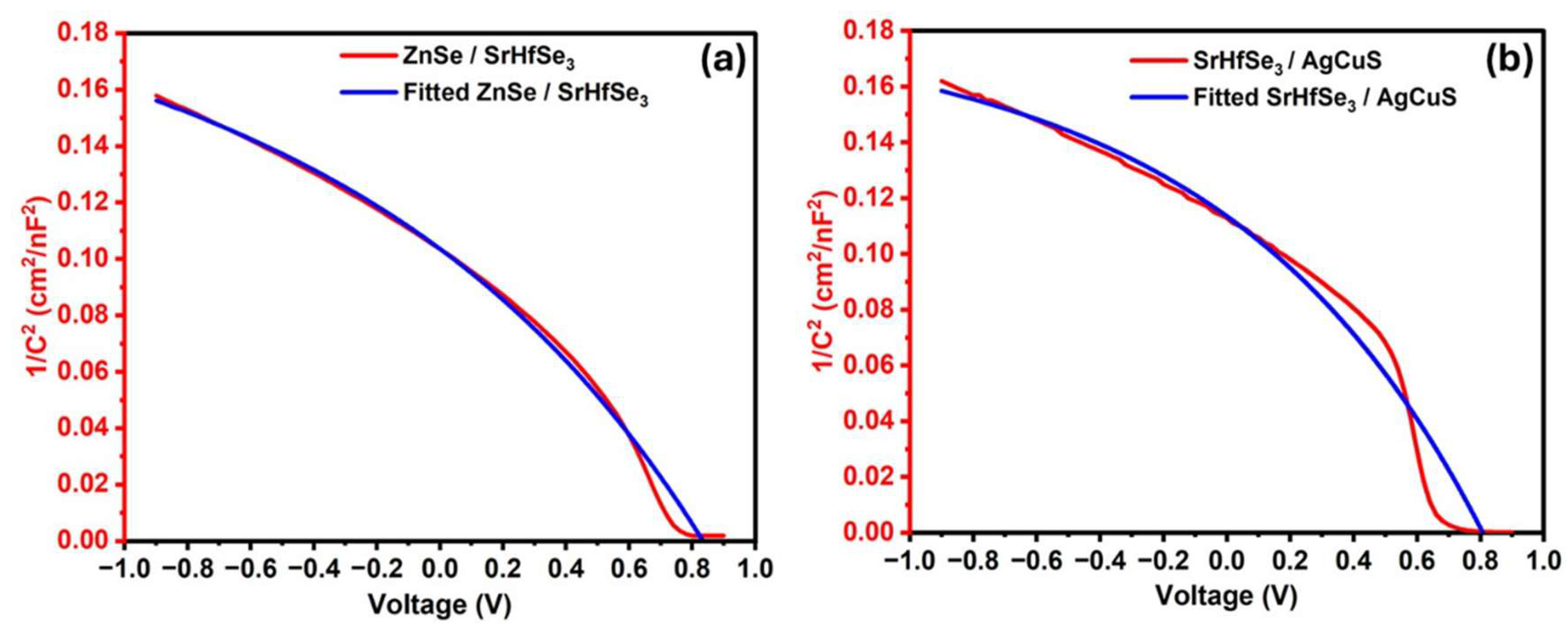

| Layer | χ (eV) | Eg (eV) | Ec (eV) | Ev (eV) |
|---|---|---|---|---|
| ZnSe | 4.09 | 2.70 | –4.09 | – 6.79 |
| SrHfSe3 | 3.90 | 1.02 | –3.90 | –4.92 |
| AgCuS | 3.90 | 1.25 | –3.35 | – 4.60 |
| Structure | ZnSe [41] | SrHfSe3 [34,40] | AgCuS [31] |
|---|---|---|---|
| Thickness (µm) | 0.05 | 1 | 0.2 |
| Bandgap (eV) | 2.7 | 1.02 | 1.25 |
| Electron Affinity (eV) | 4.09 | 3.9 | 3.350 |
| Dielectric permittivity | 10.000 | 7.45 | 10.000 |
| Effective DOS at CB (cm−3) | 1.50 × 1018 | 5.60 × 1018 | 1.99 × 1019 |
| Effective DOS at VB (cm−3) | 1.800× 1019 | 5.40 × 1018 | 1.72 × 1019 |
| Thermal velocity of electron (cm−1) | 1.00 × 107 | 1.00 × 107 | 1.00 × 107 |
| Thermal velocity of holes (cm−1) | 1.00 × 107 | 1.00 × 107 | 1.00 × 107 |
| Electron mobility (cm2 cm−1s−1) | 5.00 × 101 | 3.647 ×101 | 1.00 × 102 |
| Hole mobility (cm2 cm−1s−1) | 6.094 × 101 | 6.094× 101 | 6.60 × 101 |
| Bulk defect density (cm−3) | 1.00 × 1015 | 1.00 × 1014 | 1.00 × 1015 |
| Shallow uniform acceptor density NA (cm−3) | 0 | 1.00 × 1017 | 1.00 × 1019 |
| Shallow uniform doner density Nd (cm−3) | 1.00 × 1018 | 0 | 0 |
| Contacts | Unit | Back Contact Parameters | Front Contact Parameters |
|---|---|---|---|
| Metal work function | eV | 4.7 [31] | 3.84 [55] |
| Surface recombination velocity of holes | cm/s | 1.00 × 107 | 1.00 × 107 |
| Surface recombination velocity of holes | cm/s | 1.00 × 107 | 1.0 × 107 |
| Structure | Responsivity (A/W) | Detectivity (Jones) | Wavelength (nm) |
|---|---|---|---|
| ZnSe/SrHfSe3 | 0.675 | 1.94 × 1013 | 1040 |
| ZnSe/SrHfSe3/ AgCuS | 0.85 | 2.26 × 1014 | 1100 |
Disclaimer/Publisher’s Note: The statements, opinions and data contained in all publications are solely those of the individual author(s) and contributor(s) and not of MDPI and/or the editor(s). MDPI and/or the editor(s) disclaim responsibility for any injury to people or property resulting from any ideas, methods, instructions or products referred to in the content. |
© 2025 by the authors. Licensee MDPI, Basel, Switzerland. This article is an open access article distributed under the terms and conditions of the Creative Commons Attribution (CC BY) license (https://creativecommons.org/licenses/by/4.0/).
Share and Cite
Abdo, S.; Odebowale, A.A.; Abdulghani, A.; As’ham, K.; Akter, S.; Hattori, H.; Kanizaj, N.; Miroshnichenko, A.E. Unveiling the Potential of Novel Ternary Chalcogenide SrHfSe3 for Eco-Friendly, Self-Powered, Near-Infrared Photodetectors: A SCAPS-1D Simulation Study. Sci 2025, 7, 113. https://doi.org/10.3390/sci7030113
Abdo S, Odebowale AA, Abdulghani A, As’ham K, Akter S, Hattori H, Kanizaj N, Miroshnichenko AE. Unveiling the Potential of Novel Ternary Chalcogenide SrHfSe3 for Eco-Friendly, Self-Powered, Near-Infrared Photodetectors: A SCAPS-1D Simulation Study. Sci. 2025; 7(3):113. https://doi.org/10.3390/sci7030113
Chicago/Turabian StyleAbdo, Salah, Ambali Alade Odebowale, Amer Abdulghani, Khalil As’ham, Sanjida Akter, Haroldo Hattori, Nicholas Kanizaj, and Andrey E. Miroshnichenko. 2025. "Unveiling the Potential of Novel Ternary Chalcogenide SrHfSe3 for Eco-Friendly, Self-Powered, Near-Infrared Photodetectors: A SCAPS-1D Simulation Study" Sci 7, no. 3: 113. https://doi.org/10.3390/sci7030113
APA StyleAbdo, S., Odebowale, A. A., Abdulghani, A., As’ham, K., Akter, S., Hattori, H., Kanizaj, N., & Miroshnichenko, A. E. (2025). Unveiling the Potential of Novel Ternary Chalcogenide SrHfSe3 for Eco-Friendly, Self-Powered, Near-Infrared Photodetectors: A SCAPS-1D Simulation Study. Sci, 7(3), 113. https://doi.org/10.3390/sci7030113







